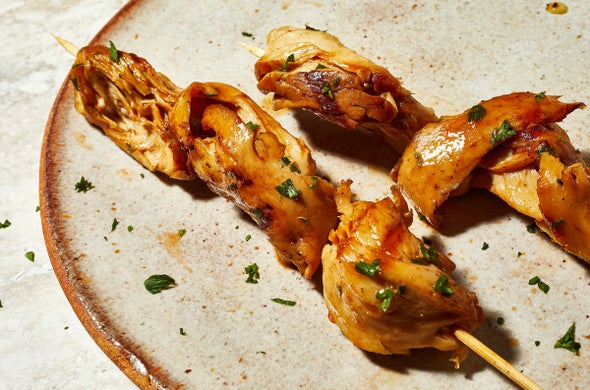Cultured meat, grown from real animal cells, will soon be available in restaurants in San Francisco and Washington, D.C.
Thank you for reading this post, don't forget to subscribe!
Around 90 percent of the U.S. population eats meat regularly. But a growing number of Americans harbor concerns about the current meat industry’s environmental impact, which accounts for about 14.5 percent of global carbon emissions. Massive livestock operations can also be breeding grounds for harmful antibiotic-resistant bacteria. What’s more, they generate tons of waste and can pollute local waterways with nutrient runoff from manure. And the animals themselves often live relatively short lives, confined to cramped cages and standing in their own filth. “We think the current way of producing meat is at the very tip of the spear of all these harms,” says GOOD Meat CEO Josh Tetrick.
Still, people are drawn to eating meat for a variety of reasons, such as cultural significance and tradition or its nutritional value as a protein source—not to mention its taste. Cultured meat companies, which bill themselves as sustainable and cruelty-free, hope their products will offer a way for meat lovers to enjoy a juicy burger or fried chicken with a clean conscience. “I put myself in that category,” says Amy Chen, COO of UPSIDE Foods. “We call ourselves ‘conflicted carnivores.’”
A lab-grown chicken nugget starts the classic way: with an egg. Food scientists sample stem cells from a fertilized chicken egg and then test the cells for resilience, taste, and the ability to divide and create more cells. Next the scientists can freeze the best cell lines for future use.
When it’s time to start production, food scientists submerge the cells in a stainless steel vat of nutrient-rich broth containing all the ingredients cells need to grow and divide. After a few weeks, the cells begin to adhere to one another and produce enough protein to harvest. Finally, the scientists texturize the meat by mixing, heating or shearing it—GOOD Meat uses an extruder—and press it into nugget or cutlet shape.
The overall production process is relatively simple, says Vítor Santo, GOOD Meat’s cell agriculture director. “The biggest challenge right now is definitely building the manufacturing capacity,” he says. UPSIDE Foods’ COO, Amy Chen, concurs. “Industrial farming has had a head start,” she says. But now that both companies have USDA and FDA approval, they can start to build up the infrastructure to cultivate enough meat to ship products across the U.S.
For now, their cultured chicken will only be available in a couple of restaurants. Bar Crenn, a Michelin-starred restaurant in San Francisco, will serve UPSIDE Foods. And celebrity chef José Andrés, a member of GOOD Meat’s board of directors, will serve the company’s cultured chicken at one of his restaurants in Washington, D.C.
Until cultured meat is produced on a larger scale, its proposed environmental benefits remain untested. “The presumption—and I say ‘presumption’ carefully—is that, yes, you’ll have a more sustainable food production system,” says David Kaplan, a bioengineer at Tufts University. Cultured meat production facilities, at the very least, will consume drastically less land and water than traditional agriculture and directly emit fewer greenhouse gases, though their total eventual carbon footprint at a mass-production scale is unclear.
Sustainability plus flavor is a promise that plant-based protein companies, such as the meatless juggernaut Impossible Foods, have been trying to deliver for nearly a decade. While these products have gained popularity—and landed on fast-food menus—they haven’t seen the level of adoption the industry had been hoping for. Cell-cultivated meats could help bridge that gap. “Ultimately, we think people will be more likely to switch if the product is actually meat,” Tetrick explains.
If cultured meat is both slaughter-free and better for the environment, will any vegetarians adopt it into their diet? “We have a range of views,” says Richard McIlwain, chief executive of the Vegetarian Society of the United Kingdom. Some vegetarians are stoked about the prospect of cell-cultivated meat, but about half would prefer to avoid it, according to one poll. Acceptance is a little higher for the rest of the public: nearly two thirds of U.S. citizens are at least willing to give lab-grown meat a try.
For folks who keep a kosher or halal diet, the issue is a bit less clear-cut. In 2021 Indonesian Islamic authorities ruled that cultivated meat was not halal, though other Muslim leaders are open to the possibility of halal certification depending on how the cell lines are harvested. A cell cultivation start-up based in Israel is currently seeking market approval for its kosher-certified meat.
When the products do hit supermarket shelves, Chen says, “they will actually bear the stamp and seal that you expect on a piece of meat”: a little round tag certifying USDA inspection. The labels will also include the prefix “cell-cultured” to distinguish the meat from conventional barnyard fare. And they will lack an official “vegetarian” stamp of approval. The Vegetarian Society’s standpoint is that lab-grown meat doesn’t qualify as vegetarian or vegan because it contains cells originally sampled from an animal. The organization, however, will consider creating a new label to certify it as “cruelty-free” or “slaughter-free,” McIlwain says.
“I think it’s going to need its own criteria,” he adds. “But we are very excited about [cell-cultivated meat] from a societal perspective.”
ABOUT THE AUTHOR(S)
Joanna Thompson is an insect enthusiast and former Scientific American intern. She is based in New York City. Follow Thompson on Twitter @jojofoshosho0

